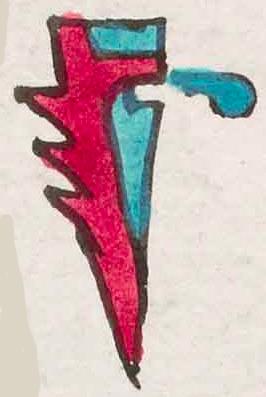Huitznahuac (Mdz19r)
This compound glyph for the place name Huitznahuac contains two principal elements, a vertical thorn or spine (huitztli), painted turquoise blue and red, with its point down. The spine has additional thorns running up its left side. It also has an open, toothless mouth from which a speech scroll emerges (toward the viewer's right), suggesting the noun nahuatl), for speech, language, agreeable sounds. This scroll is also painted turquoise blue.
Stephanie Wood
The speech element is actually meant to call up the locative, -nahuac, near or next to, probably referring to a place where maguey spines or thorns were plentiful. The thorn (huitztli) may be colored red for blood, given that thorns were used for bloodletting and for cutting people who were being punished. The turquoise color may be an indication of preciosity. Incidentally, Huitznahuatl, literally "Thorn Speech," is a title that was held by a dignitary, as shown on folio 66 recto of the Codex Mendoza. The glyph for his title is just the same as this one.
John Bierhorst (A Nahuatl-English Dictionary and Concordance to the Cantares Mexicanos, 1985, 143) says that Huitznahuatl was a "name or epithet of a god to whom slaves were sacrificed in Mexico." Other sources report that one of the ethnic groups that migrated from the Seven Caves came from a place called Huitznahuac, and there was a temple with this association in Mexico Tenochtitlan. Finally, Huitznahuatl was a high title, and it had an association with the South. The name was not inaccessible for tribute-paying men of humble means, such as found in the census of modern-day Morelos and in the Matrícula de Huexotzinco (modern-day Puebla). See the Online Nahuatl Dictionary for more information about Huitznahuac and Huitznahuatl.
Stephanie Wood
huitznahuac
Huitznahuac
Stephanie Wood
c. 1541, or by 1553 at the latest
Stephanie Wood
espinas, espinosa, thorns, spiny, speech, el habla, language, lenguaje

huitz(tli), thorn, spike, spine, https://nahuatl.wired-humanities.org/content/huitztli
-nahuac (locative suffix), near or next to, https://nahuatl.wired-humanities.org/nahuac
nahua(tl), language/speech, https://nahuatl.wired-humanities.org/content/nahuatl
-c (locative suffix), https://nahuatl.wired-humanities.org/content/c
"Beside the Large Maguey Spine" (agreeing with Berdan and Anawalt) [Frances Karttunen, unpublished manuscript, used here with her permission.]
"Near the Thorns" (Gordon Whittaker, Deciphering Aztec Hieroglyphs, 2021, 103); "Beside the Large Maguey Spine" (Berdan and Anawalt, 1992, vol. 1, p. 189)
HUITZ•NAHUAC
"Cerca del Espino del Maguey"
Stephanie Wood
Codex Mendoza, folio 19 recto, https://digital.bodleian.ox.ac.uk/objects/2fea788e-2aa2-4f08-b6d9-648c00..., image 48 of 188.
The Bodleian Libraries, University of Oxford, hold the original manuscript, the MS. Arch. Selden. A. 1. This image is published here under the UK Creative Commons, “Attribution-NonCommercial-ShareAlike 3.0 License” (CC-BY-NC-SA 3.0).






